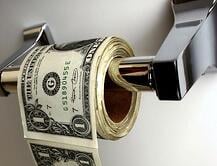 By Douglas R. BrownAtlantic Publishing
By Douglas R. BrownAtlantic Publishing
Part 3: Purchasing Ideas
There are many ways to curb cost. Here are a few ideas:
- Inexpensive fish. Turn your customers on to seafood alternatives and lower your food cost. Consider using some alternatives such as Tilapia, farm-raised salmon, fresh-water perch, Alaskan halibut, mahi-mahi, shark or skate. Skate, for example, can be purchased wholesale right now online for $1.62 per pound. The secret, of course, is to make certain it is fresh.
- Shelled eggs. Consider buying shelled eggs if your restaurant uses more than three cases of eggs per week. This will reduce the amount of cardboard and other packaging that must be disposed or recycled. Shelled eggs are often packaged in 5-gallon buckets that can later be reused for cleaning or maintenance.
- Condiments. Use refillable condiment dispensers instead of individual condiment packets for dine-in customers.
- Cost-Watch Web site. This site, www.cost-watch.com, helps restaurant management control labor, utility and food and beverage costs. It also offers regional reports to compare expenses and food costs in similar restaurants as well as price trend forecasts. It is a great resource for purchasing managers.
- Join a barter club. Bartering allows you to buy what you need and pay for it with otherwise unsold products, such as food and beverages or even catering services. Almost anything and everything can be purchased with barter services. Nationally, over 250,000 businesses are involved in barter. Check out these Web pages:
www.barterwww.com
www.barterbrokers.com
www.netlabs.net/biz/itex/index.htm
- Similar ingredients. Include menu items that are essentially made with similar ingredients as others on the menu. For example, a shrimp cocktail and shrimp pasta are two very different meals, but the ingredients are similar. These ingredients are simple, inexpensive and don't take up a lot of storage space. Having five or six other pasta sauces to offer also loads up your menu with choices without excessively increasing your inventory. This will not only allow you to buy in bulk and keep costs down, but will also lighten the load on your kitchen staff.
- Bread baskets. The potential for waste in bread baskets is large. Most of these come back from the table partially eaten at best. You may want to consider giving bread baskets only if requested or you may want to cut down on the amount served. You should also consider including packaged items since these can be reused. Some operators are now serving bread only by request or they are serving one roll or breadstick at a time from a breadbasket with tongs.
- Substitute premade items. Substitute premade items for some items you have been making from scratch. You don't have to sacrifice quality to do this; many premade items are good. You can also start with a premade item and add ingredients. For instance, you can buy a premade salad dressing and add blue cheese or fresh herbs. Using these items will lower your food and labor costs, and you can still put out a quality item.
Topics:
inventory managers,
Hotel Inventory,
Restaurant Inventory,
food inventory,
inventory schedule,
inventory counting,
purchasing,
inventory control,
Food control
By Douglas R. BrownAtlantic Publishing
Part 5: Purchasing and Ordering--Procedures and Practices
Purchasing and Ordering
What exactly is the difference? Purchasing is setting the policy on which suppliers, brands, grades and varieties of products will be ordered. These are your standardized purchase specifications; the specifics of how items are delivered, paid for and returned. These specifications are negotiated between management and distributors. Basically, purchasing is what you order and from whom. Ordering, then, is simply the act of contacting the suppliers and notifying them of the quantity you require. This is a simpler, lower-level task. Here are the basics:
- Develop a purchasing program. Once menus have been created that meet your customers' satisfaction and your profit needs, develop a purchasing program that ensures your profit margins.
- An efficient purchasing program incorporates: Standard purchase specifications based on standardized recipes, and standardized yields and portion control that allow for accurate costs based on portions actually served.
- Keep in mind: Purchasing more than you need usually results in poor portioning, excess spoilage, waste and theft. Not buying enough can mean paying retail prices, or using a more expensive substitute.
- Purchasing procedures. These procedures should include creating written purchasing specifications for every product and selecting good, reliable purveyors. Your purchasing procedures should do three things:
- Allow you to purchase the required items at prices that meet your food cost goals.
- Maintain control over your existing inventory.
- Establish a set of procedures to be sure that you receive quality product at the best price.
- Purchasing responsibility. Either take on the purchasing yourself or assign a specific employee to do it. Make sure that this person keeps current with ever-changing food prices.
- Price checks for different vendors. Sometimes you may find that one vendor is less expensive than another for a while, and then this may shift. Keep current with competing vendors' prices.
Purchasing Specifications
By creating purchasing specifications, you can control which items you purchase and you can maintain product consistency. This information is extremely important if you have more than one person that does ordering in your operation. You need to record the following basic information:
- Purchasing specifications. They state the exact requirements for the amount and quality of items purchased. These specifications should include:
-
- Product name
- Quantity to be purchased (designated with correct unit such as pounds, can size, etc.)
- Indication of grade, if applicable
- Unit by which prices are quoted
- What the product will be used to produce
- Meats. Meats should be inspected by the USDA or
other appropriate agency. The parts or packaging
should carry a federal or state inspection stamp.
- Eggs. Eggs should have a USDA grade; frozen and
dried eggs should be pasteurized.
- Shellfish. Shellfish should be purchased from
suppliers that appear on public health service Food
and Drug Administration lists of Certified Shellfish
Shippers or on lists of state-approved sources. The
control tags must be available if live shellfish are
used.
- Introduce a record sheet. Make it readily available for all your employees. They need to be sure that they're ordering the correct items in the correct amounts. You're also more likely to attain your desired food cost by keeping these records and maintaining purchasing controls. Keeping your food cost down will help you to maximize profits from your menu prices. The following form illustrates an example of a purchasing specification form:

This article is an excerpt from the Food Service Professional Guide to Controlling Restaurant & Food Service Food Costs, authored by Douglas R. Brown, published by Atlantic Publishing Company. This excerpt has been reprinted with permission of the publisher. To purchase this book go to:
Atlantic Publishing Company
Amazon.com
Topics:
inventory,
Restaurant Inventory,
food inventory,
Control,
Hospitality,
inventory schedule,
inventory counting,
controling costs,
purchasing,
inventory control
By Douglas R. BrownAtlantic Publishing
Part 4: Purchasing Basics
The goal of purchasing is to obtain wholesome, safe foods to meet your menu requirements. The operation must have food to serve customers when needed. The food needs to be the right quality consistent with the operation's standards and purchased at the lowest possible cost.
- Vendors and food safety. Food safety at this step is primarily the responsibility of your vendors. It's your job to choose your vendors wisely.
- Suppliers must meet federal and state health standards. They should use the HACCP system in their operations and train their employees in sanitation.
- Delivery trucks. Delivery trucks should have adequate refrigeration and freezer units, and foods should be packaged in protective, leak-proof, durable packaging. Let vendors know upfront what you expect from them. Put food-safety standards in your purchase specification agreements. Ask to see their most recent board of health sanitation reports, and tell them you will be inspecting trucks on a quarterly basis.
- Delivery schedules. Good vendors will cooperate with your inspections and should adjust their delivery schedules to avoid your busy periods so that incoming foods can be received and inspected properly.
- Your inventory system is the critical component of purchasing. Before placing an order with a supplier, you need to know what you have on hand and how much will be used. Allow for a cushion of inventory so you won't run out between deliveries. Once purchasing has been standardized, the manager simply orders from your suppliers. Records show supplier, prices, unit of purchase, product specifications, etc. This information needs to be kept on paper and preferably computerized. Purchase food items according to usage. For example, if you plan to use tomatoes by blending and mixing them with other ingredients to make a sauce, purchase broken tomatoes as opposed to whole tomatoes. However, if you intend to use tomatoes to decorate a dinner plate or as a topping, opt for high-quality produce, such as baby plum vine-grown tomatoes.
This article is an excerpt from the Food Service Professional Guide to Controlling Restaurant & Food Service Food Costs, authored by Douglas R. Brown, published by Atlantic Publishing Company. This excerpt has been reprinted with permission of the publisher. To purchase this book go to:
Atlantic Publishing Company
Amazon.com
Topics:
inventory managers,
Hotel Inventory,
Restaurant Inventory,
food inventory,
Control,
inventory schedule,
inventory counting,
controling costs,
inventory control
 By Douglas R. BrownAtlantic Publishing
By Douglas R. BrownAtlantic Publishing





